piano
Elgar - Chanson de Matin - Fl & Pf
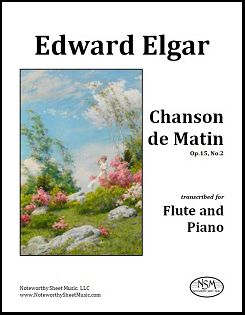 Chanson de Matin, Op.15, No.2, by Edward Elgar
Chanson de Matin, Op.15, No.2, by Edward Elgar
Transcribed for Flute and Piano by C.A.Vater
Flute Part and Piano Score, PDF $6.99
Edward Elgar composed his Chanson de Matin for violin and piano c.1889-1890. The two companion pieces, Chanson de Matin (No. 2) and Chanson de Nuit (No. 1), together constitute his Op.15, and both pieces were later arranged for small orchestra by the composer. Chanson de Matin was received with great enthusiasm, and its initial and lasting popularity can be attributed largely to its strong melodic appeal. Enduring public affection for the piece has spawned the creation of numerous arrangements and transcriptions, including renditions for cello and piano, viola and piano, flute and guitar, piano solo, organ solo, and string quartet. Noteworthy Sheet Music offers two of our own transcriptions of the lovely Chanson de Matin, one for alto flute and piano and one for concert flute and piano.
Flute part, 2 pages; Piano Score, 4 pages; Total, 12 pages.
PreviewElgar – Mot d’Amour – Alto Flute & Piano
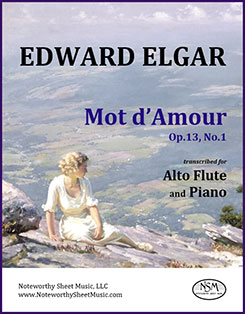 Mot d’Amour, Op.13, No.1, by Edward Elgar
Mot d’Amour, Op.13, No.1, by Edward Elgar
Transcribed for Alto Flute and Piano by C. A. Vater
Piano Score and Part for Alto Flute, PDF $5.49
In 1888, Elgar composed Salut d’Amour, now one of his most-recognized pieces, as an engagement gift for his beloved fiancée. Later he wrote Mot d'Amour (Love's Word) for violin and piano as a companion piece to Salut d’Amour. Mot d'Amour, which was initially given the German title Liebesahnung, was published in 1889 by Osborn & Tuckwood in the edition 2 Pieces for Violin & Piano that included this piece and a second one, less well-suited to alto flute, called Bizarrerie. Mot d’Amour is similar to Salut d’Amour in being light, charming, and highly romantic. Although Mot d’Amour never attained the level of popularity achieved by the earlier work, it is considered by some to be the finer composition (https://www.elgar.org/3salut.htm). Both Salut d’Amour and Mot d'Amour sound especially rich and mellow when performed on alto flute, and both pieces are now available from Noteworthy Sheet Music as transcriptions for alto flute and piano, adapted from the composer’s violin and piano editions now in the public domain and available on imslp.org.
Score, 4 pages; Alto Flute part, 1 page; Total, 8 pages.
Elgar – Salut d’Amour – Alto Flute & Piano
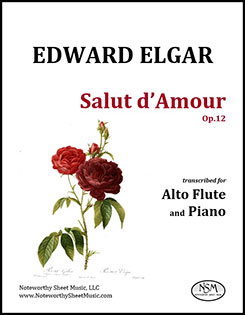 Salut d’Amour, Op. 12, by Edward Elgar
Salut d’Amour, Op. 12, by Edward Elgar
Transcribed for Alto Flute and Piano by C. A. Vater
Piano Score and Part for Alto Flute, PDF $6.99
The English composer Edward Elgar held many positions throughout his career, including those of organist at St. George’s Roman Catholic Church in Worcester, conductor of the Worcester Philharmonic, Professor of Music at the University of Birmingham, and conductor of the London Symphony Orchestra. He achieved considerable prominence as a result of his many successful orchestral, vocal, and chamber music compositions. Elgar composed this piece in 1888, as an engagement gift to his beloved future wife. Though first written for piano solo, arrangements were created shortly thereafter by the composer himself for violin and piano, and for orchestra. Originally titled “Liebesgruss” (Love’s Greeting), but later changed to Salut d’Amour, the piece is now one of Elgar’s most widely recognized works, and its immense popularity has led to arrangements for a wide variety of other instruments. We provide here a transcription of Salut d’Amour for alto flute and piano, which has been adapted from the editions published by Schott for violin and piano, oboe and piano, or orchestra and which are now in the public domain.
Score, 4 pages; Alto Flute part, 2 pages; Total, 10 pages.
PreviewFauré - Berceuse - Alto Flute & Piano
Berceuse, Op.16, by Gabriel Fauré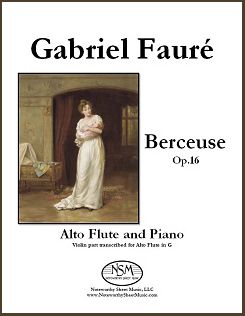
Transcribed for Alto Flute and Piano by C.A.Vater
Piano Score and Alto Flute Part, PDF $6.99
Gabriel Fauré composed his Berceuse (Op. 16) for violin (or cello) and piano in 1878-1879, and it was first published by J. Hamelle, Paris. To this day, the Berceuse remains one of Fauré's most beloved and popular works. The piece is simple but beautiful, short, with a quiet sweet melody that appeals to both performers and audiences alike. It is no wonder that over the years the Berceuse has been transcribed for many other instruments; arrangements have been created for solo piano, viola, flute, alto saxophone, flute and harp, and string quartet, in addition to the composer's own arrangement for violin and orchestra.
Now, in response to an excellent suggestion we received from one of our customers, we add our own version of the Fauré Berceuse, a transcription for alto flute and piano. Perhaps we are biased, but we think the alto flute is a wonderful instrument choice for this lullaby. The piece is suitable for players of all levels.
Alto Flute part, 2 pages; Piano Score, 5 pages; Total, 12 pages.
PreviewFauré - Pièce - Alto Flute & Piano
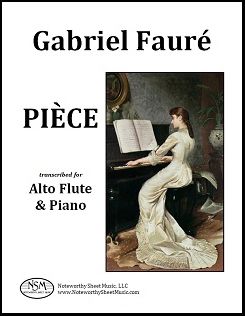 Pièce (Vocalise-Étude), by Gabriel Fauré
Pièce (Vocalise-Étude), by Gabriel Fauré
Transcribed for Alto Flute and Piano by C.A.Vater
Alto Flute Part and Piano Score, PDF $4.99
Vocalises are songs without words written to provide technical challenges for singers; they are designed to develop flexibility and control, and thus often serve as vocal warm-up exercises. Gabriel Fauré composed his Vocalise-Étude in 1906, and it was published by Leduc the following year. The original piece, in the key of E minor and marked Adagio molto tranquillo, includes a piano accompaniment and incorporates various difficulties for the vocal soloist, including wide intervals, unexpected harmonies, and demanding rhythms.
Fauré's Vocalise-Étude has long been recognized as a particularly lovely and poignant piece of music, not merely a vocal exercise but a musical work of intrinsic beauty. Under its alternative name Pièce, the Vocalise-Étude has been transcribed for various orchestral instruments, including bassoon and piano, flute and piano, and oboe and harp. We at Noteworthy Sheet Music think the alto flute, with its rich, mellow tone, is the perfect instrument for this moving and somewhat melancholy Fauré melody. Our transcription for alto flute and piano is based on the version of the Vocalise-Étude for medium voice, in the key of D minor, published by Alphonse Leduc in 1907 and now in the public domain.
Alto Flute part, 1 page; Piano Score, 3 pages; Total, 8 pages.
PreviewFoster - Old Folks; Oh! Susanna - Vo/Pf/Fl/Vc
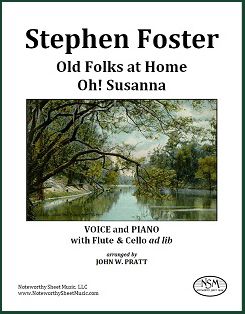 Old Folks at Home and Oh! Susanna, by Stephen Foster
Old Folks at Home and Oh! Susanna, by Stephen Foster
Arranged with Flute and Cello ad lib by John W. Pratt
Flute Parts, Cello Parts, Voice Parts, and Piano Scores ― PDF $7.99
The following excerpts are taken from John W. Pratt's foreword to the edition:When a Golden Oldie comes to mind, Doo-dah! Doo-dah!
Comic, sad, or any kind, Oh! Doo-dah-day!
Jeanie, Swanee, Kentucky, Joe, Doo-dah! Doo-dah!
Beautiful, dreamy, fast, or slow, Oh! Doo-dah-day!
I'll bet I know who wrote it, he wrote them night and day,
Stephen Foster wrote it, he'll never go away.
Stephen Foster was born in Lawrenceville, Pa., on July 4, 1826...He wrote over 200 songs, including 135 parlor songs, 28 minstrel songs, and 21 hymns and Sunday school songs. A remarkable number are memorable, as the ditty above will attest to anyone with anything like my background. One wonders why. The harmonies and rhythms are basic, as are the forms and rhyme schemes (see above), the music is repetitious, and the vocal range rarely goes outside an octave (a great benefit for community singing). Yet the fit is so natural and the pacing so well judged that the songs are ideally effective and diabolically catchy. Foster is perhaps, though on a different plane, the Mozart of his field...
For a pianist playing several stanzas at a sing-along, Foster's songs do become a little dull. But their very simplicity, repetitiousness, and familiarity abet variation as, again on a different plane, chorales serve Bach chorale preludes. Like chorale preludes, the piano parts here always incorporate the melody, so they can be played solo or to accompany amateur singers. It struck me that they could be enhanced by optional flute parts. After writing them, I discovered that, according to his brother Morrison, Foster himself "delighted in playing accompaniments on the flute...As the song went on he would improvise...the most beautiful variations upon its musical theme." If Foster's improvisations were like the one his brother published, however, they just varied the melody itself in the manner of the period. My game is more ambitious, as you will easily see. I added optional cello parts, mostly for color, as in the Haydn trios but superficially more interesting for the cellist. (Again we are on a different plane, of course.)
"Oh! Susanna," one of the best-known American songs by anybody, is Foster's "Erlkönig." (Speak of different planes!) With its nonsensical lyrics and polka beat, it is clearly comical, and I treated it accordingly. It was written in Cincinnati, possibly for a social club, first performed at an ice cream saloon in Pittsburgh in 1847, and published in 1848. When no American song had sold over 5,000 copies, it sold over 100,000. It earned Foster only $100, but its popularity led to a publisher's offer, convincing him to become a professional songwriter, America's first.
"Old Folks at Home" established Foster as a truly American composer. It was written in 1851 for a blackface troupe whose leader paid Foster about $15 to be credited for it. When almost finished, Foster asked his brother for "a good name of two syllables for a Southern river." He rejected Yazoo and Pedee, but was delighted with Swanee, a shortening of Suwanee, a small river in Florida which his brother found in an atlas. Though about a slave's nostalgia for home, I find its theme universal and melancholy and I resisted the temptation to jazz it up. Please try, at least, a slowish tempo.
― John W. Pratt, May 27, 2013 ©
Flute parts, 2 pages; Cello parts, 2 pages; Voice parts, 2 pages; Scores, 7 pages; Total, 18 pages.
PreviewFürstenau - Adagio et Rondo Brillant - Fl & Pf
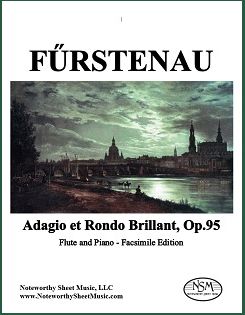 Adagio et Rondo Brillant, Op.95, by A. B. Fürstenau
Adagio et Rondo Brillant, Op.95, by A. B. Fürstenau
Gassett Collection - Facsimile Edition by C.A.Vater/Noteworthy Sheet Music with a Foreword by Peter H. Bloom
Flute Part and Piano Score, PDF $12.00
Anton Bernhard Fürstenau (1792-1852) was among the most revered flutists of the 19th century. Following his appointment to the post of principal flute for the Royal Chapel at Dresden in 1820, Fürstenau became a valued colleague and close personal friend of the court's music director, Carl Maria von Weber. The influence of Weber's dramatic melodic gestures and edgy harmonic shifts can be heard in this passionately evocative Adagio et Rondo Brillant. An NSM favorite!
For additional information about the Gassett Collection, please see see our article An Introduction to the Gassett Collection.
Piano score, 12 pages; Flute part, 4 pages; Total, 20 pages.
PreviewGabrielsky - Adagio et Variations - Fl & Pf
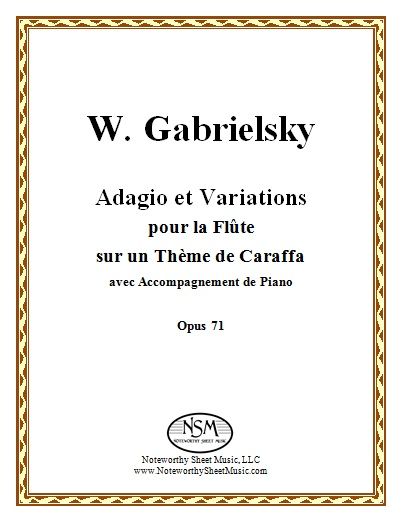 Adagio et Variations pour la Flûte sur un Thême de Caraffa, Op. 71, by W. Gabrielsky
Adagio et Variations pour la Flûte sur un Thême de Caraffa, Op. 71, by W. Gabrielsky
Gassett Collection - New Edition by Noteworthy Sheet Music
Flute Part and Piano Score, PDF $18.75
Johann Wilhelm Gabrielski (or Gabrielsky), 1795-1846, was an acclaimed German flutist and composer from Berlin. In 1814 Gabrielski secured a position as flutist at the theatre in Stettin and within two years was appointed to the Royal Court. Gabrielski's compositions, of which there are more than 100, were highly esteemed and popular in his day. Although these works have much to offer modern day flutists as well, Gabrielski's music is neither widely known nor readily available today. The Adagio et Variations pour la Flûte, Op. 71, exploits melodic material by Michele Enrico Carafa (Caraffa) di Colobrano (1787-1872), a Naples born musician who had a remarkably successful career in Paris as a composer for the Opéra-Comique and as a professor of composition and counterpoint at The Conservatoire. The work showcases the flutist's virtuosity, atop a relatively uncomplicated piano accompaniment.
For additional information about the Gassett Collection, please see see our article An Introduction to the Gassett Collection.
Flute part, 11 pages; Piano Score, 16 pages; Total, 31 pages.
PreviewGaubert - Deux Esquisses - Clarinet and Piano
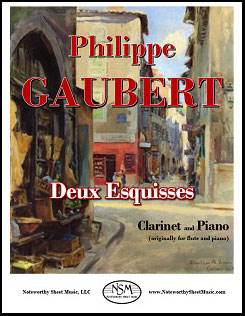 Deux Esquisses, by Philippe Gaubert
Deux Esquisses, by Philippe Gaubert
transcribed for Clarinet and Piano by C. A. Vater
Clarinet part and Piano score, PDF $9.99
Philippe Gaubert was a prominent French flutist, composer, and conductor who held a professorship at the Paris Conservatory and principal conducting positions at the Paris Opéra and the Orchestre de la Société des Concerts du Conservatoire. We’ve created a transcription of his Deux Esquisses (Two Sketches) for B♭ clarinet, complete with piano score. These pieces were written for flute and piano but are nicely adaptable for other winds. They were originally published by Heugel & Cie, in 1915 (No.1) and 1914 (No.2), and are now in the public domain. No.1, Soir sur la Plaine (Evening on the Plain), opens intriguingly with the solo instrument playing alone, repeating a single note. This motif sets the lovely, mysteriously forlorn tone of Soir sur la Plaine, and returns multiple times later in the piece. No.2, the second sketch, is Orientale, which, as its name suggests, evokes an atmosphere seemingly strange and foreign, Eastern.
Piano Score, 10 pages; Clarinet part, 4 pages; Total, 20 pages.
PreviewGifford - The Pied Piper of Hamelin - An Operetta
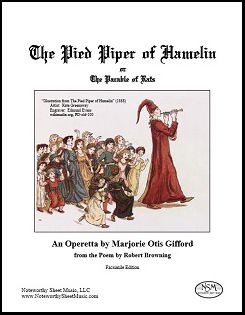 The Pied Piper of Hamelin, by Marjorie Otis Gifford
The Pied Piper of Hamelin, by Marjorie Otis Gifford
An Operetta, from the Poem by Robert Browning
Facsimile Edition by Noteworthy Sheet Music, LLC, PDF $24.99
Marjorie Otis Gifford (1909-2003) was a composer, choirmaster, and long-time music and piano teacher in CT and NY. At age 24, she put music to Robert Browning's classic poem The Pied Piper of Hamelin, creating a children's operetta for her students. In her preface to the operetta, Mrs. Gifford states that perhaps the best performance of The Pied Piper was at the Lenox School in NYC, where she was teaching in 1938; that production was directed by Antoinette Perry, who later became known as 'Tony' of the Tony Awards. Indeed, there are additional famous personalities and much fascinating history associated with the remarkable life of Marjorie Otis Gifford.
The Pied Piper of Hamelin operetta was brought to NSM's attention by Gale Finlayson, daughter of composer and music educator Walter Finlayson, and we created our facsimile edition of the operetta at Gale's request. Marjorie Otis Gifford and Walter Finlayson were great friends, and in her preface Mrs. Gifford credits Mr. Finlayson with putting her operetta down on paper. NSM has received permission to publish the operetta from both the executor of Mrs. Gifford's estate and from Deborah O'Connor, the artist who created the charming illustrations that grace the internal pages of the operetta. We hope that, in publishing our facsimile edition, we can contribute to sustaining the legacy of Marjorie Otis Gifford and enabling future generations of young music students to perform and enjoy her work.
Marjorie Otis Gifford's The Pied Piper of Hamelin operetta was performed by the Rutland Youth Theatre of Rutland, VT, on March 2, 2018; click the link to visit YouTube and watch clips of this performance videotaped and posted by Ms. Finlayson.
Score with music and lyrics for voices and piano accompaniment, 67 pages; text of the Robert Browning poem addendum, 7 pages; Total, 78 pages.
